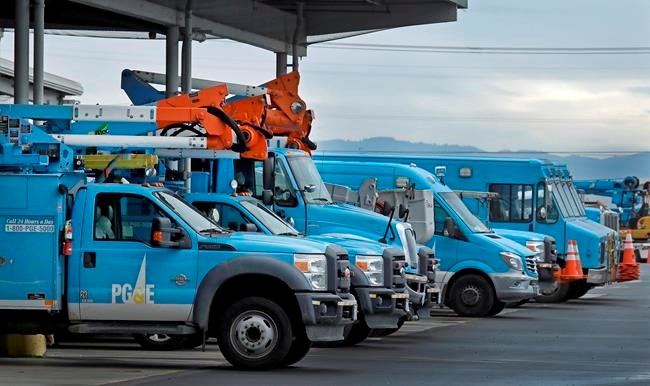SAN FRANCISCO — A federal judge on Friday said he was approving a $58 billion plan by the nation’s largest utility to end a contentious bankruptcy saga that began after Pacific Gas & Electric’s outdated equipment ignited wildfires in California that killed more than 100 people, wiped out entire towns and led the company to confess to crimes driven by its greed and neglect.
The decision by U.S. Bankruptcy Judge Dennis Montali clears the way for PG&E to pay $25.5 billion for losses from devastating fires in 2017 and 2018. The judge said he will sign the formal order confirming PG&E's plan late Friday or Saturday after the company's lawyers make a few minor revisions worked out during a two-hour hearing.
“This has been a comprehensive and complex challenge for everyone," Montali said as he thanked everyone involved in the 17-month bankruptcy case.
Dozens of lawsuits were settled during the ordeal, with $13.5 billion earmarked for more than 80,000 people who lost family, homes, businesses and other property in the fires.
“This is a great day,” said Robert Julian, a lawyer for the bankruptcy committee representing the interests of wildfire survivors. “We are going to start getting money into the hands of the victims.” It still will likely take two to three months for the plan to become effective and PG&E has raised all the money it needs to start funding the victims' trust and making other promised payments.
PG&E declined to comment, but it plans to issue a statement after Montali signs the final order. The confirmation comes ahead of a June 30 deadline that the company had to meet to qualify for coverage from a $21 billion wildfire insurance fund created by California last year.
The company still faces formidable challenges: Montali’s decision is allowing the company to emerge from its financial morass just as California heads into a summer expected to bring especially high wildfire risks.
The company plans to find a new CEO to replace Bill Johnson, who will step down June 30 after just 14 months on the job. It has overhauled board of directors, including 11 members who were just recently appointed. PG&E also has committed to slicing up its sprawling territory into regional units to be more responsive to the different needs of the 16 million people who rely on it for power.
Financing the plan requires PG&E to nearly double its debt, saddling the company with a burden its critics fear will make it more difficult to raise the estimated $40 billion for improvements that the utility still needs to make to its electrical grid.
It’s still uncertain whether PG&E is ready to meet the challenges ahead, although the company insists it’s on a new path that will result in safer and more reliable service. PG&E is still behind in its efforts to trim trees and other vegetation that serve as tinder for its power lines during dry, windy conditions.
“This does not put us into a new chapter at PG&E,” said Will Abrams, a survivor of a 2017 wildfire who had been trying to convince the judge to reject the company's bankruptcy plan. “This was an opportunity missed."
But Montali decided PG&E's plan met the bankruptcy code's standard of being “feasible" and asserted he saw no other viable alternative to pay wildfire victims who have been suffering for years.
“Mr. Abrams' desire for a better PG&E, for a better environment and a better Northern California, safe from wildfires, while aspirational and well-intended, is not something the bankruptcy code or this court can deliver," Montali wrote in a memo outlining his decision.
PG&E's shortcomings have infuriated a federal judge in a separate court case. U.S. District Judge William Alsup oversees the company’s probation following a felony criminal conviction over a natural gas explosion in 2010 that killed eight people in the San Francisco Bay Area. He wants to impose more safety requirements on PG&E to reduce wildfire risks posed by its electrical grid, but the company has resisted his efforts so far, saying it is meeting the standards of California regulators.
PG&E also expects to have to turn off power in parts of its service territory later this year to reduce wildfire risks during hot, windy weather.
Planned blackouts last year affected more than 2 million people at certain times, and the utility bungled them so badly that it had to publicly apologize and give $86 million in customer refunds.
State regulators are still investigating PG&E’s mishandling of those deliberate blackouts, which left many wondering how an area that’s home to some of the world’s most influential technology companies can’t find a way to keep the power on for days at a time. PG&E has pledged to better communicate about future outages and take steps to reduce how often they're used.
This marks the second time in 16 years that PG&E has navigated a complex bankruptcy case that has raised questions about how it should operate in the future. The last time the company emerged from bankruptcy, in 2004, electricity rates soared and management focused even more on boosting profits instead of upgrading its power supply.
Earlier this week, PG&E took the extraordinary step of pleading guilty to 84 felony counts of involuntary manslaughter for a horrific November 2018 wildfire that wiped out the town of Paradise. The inferno, known as the Camp Fire, erupted along a power system with parts that were nearly a century old. Besides the deaths, PG&E also pleaded guilty to one felony count of unlawfully starting a fire.
PG&E will pay a maximum fine of $4 million for those crimes, a penalty that incited more outrage and indignation among families of the dead who shared their heartbreaking stories before the company's sentencing. The judge said that if the same crimes had been committed by an individual instead of a company, he would have been able to sentence the person to 90 years in prison.
Michael Liedtke, The Associated Press



